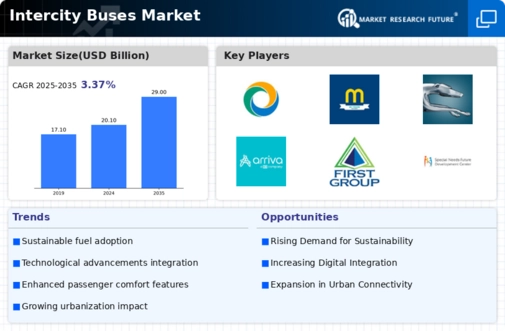Market Growth Projections
Expansion of Intercity Bus Networks
The expansion of intercity bus networks is a critical driver for the Global Intercity Buses Market Industry. Governments and private operators are increasingly investing in the development of extensive bus routes that connect urban and rural areas. This expansion not only enhances accessibility for passengers but also promotes regional tourism and economic development. As more routes become available, the convenience of bus travel is likely to attract a larger customer base. The ongoing investments in infrastructure and services are expected to bolster the market, contributing to its projected growth to 29.0 USD Billion by 2035.
Increased Focus on Passenger Safety
Passenger safety remains a paramount concern within the Global Intercity Buses Market Industry. In response to rising safety standards and regulations, bus operators are implementing advanced safety measures, including collision avoidance systems and improved vehicle maintenance protocols. These initiatives not only protect passengers but also enhance the overall reputation of bus travel as a safe mode of transportation. As safety becomes a key differentiator in the market, operators that prioritize these measures are likely to gain a competitive edge. This focus on safety is expected to support the market's growth, as consumers increasingly seek reliable and secure travel options.
Rising Fuel Prices and Cost Efficiency
The Global Intercity Buses Market Industry is also driven by the rising fuel prices that compel travelers to seek more cost-effective transportation options. Intercity buses typically offer lower fares compared to other modes of transport, making them an attractive choice for budget-conscious consumers. This cost efficiency is particularly appealing in regions where fuel prices are volatile. As a result, more passengers are likely to opt for bus travel, leading to increased demand. The market's growth is projected to maintain a CAGR of 3.37% from 2025 to 2035, indicating that the economic advantages of bus travel will continue to resonate with consumers.
Technological Advancements in Bus Design
Innovations in bus design and technology are significantly influencing the Global Intercity Buses Market Industry. Modern intercity buses are equipped with advanced features such as Wi-Fi connectivity, comfortable seating, and enhanced safety systems, which appeal to a broader audience. These enhancements not only improve passenger experience but also increase operational efficiency for bus operators. The integration of smart technologies, such as real-time tracking and automated ticketing systems, is becoming commonplace. As these advancements continue to evolve, they are expected to attract more travelers, thereby contributing to the market's growth trajectory, which is anticipated to reach 29.0 USD Billion by 2035.
Growing Demand for Sustainable Transportation
The Global Intercity Buses Market Industry is experiencing a notable shift towards sustainable transportation solutions. As environmental concerns escalate, consumers increasingly favor eco-friendly travel options. Intercity buses, which typically emit less carbon dioxide per passenger compared to cars and planes, are becoming a preferred choice for long-distance travel. This trend is bolstered by government initiatives promoting public transport and reducing carbon footprints. In 2024, the market is projected to reach 20.1 USD Billion, reflecting a growing acceptance of buses as a viable alternative to more polluting modes of transport. The emphasis on sustainability is likely to drive further growth in this sector.

















